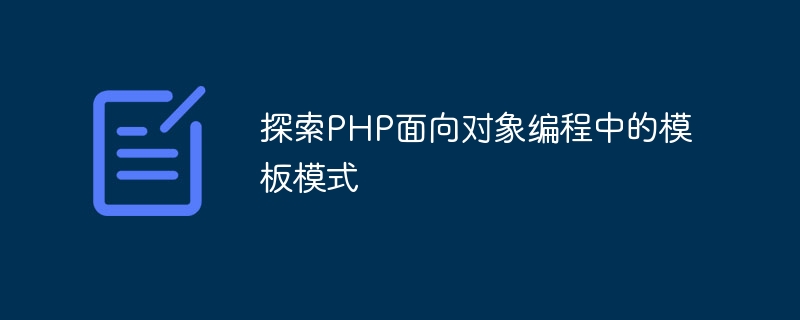Home >Backend Development >PHP Tutorial >Explore the Template Pattern in PHP Object-Oriented Programming
Explore the Template Pattern in PHP Object-Oriented Programming
- WBOYWBOYWBOYWBOYWBOYWBOYWBOYWBOYWBOYWBOYWBOYWBOYWBOriginal
- 2023-08-10 18:01:51872browse

Explore the template pattern in PHP object-oriented programming
In PHP object-oriented programming, the template pattern is an important design pattern. It allows developers to define the framework of an algorithm and offload some steps to subclasses while keeping the overall structure of the algorithm unchanged. This article will introduce the basic concepts and usage of the template pattern, and illustrate its application in PHP through an example.
The basic concept of the template pattern is to define an abstract class, which contains an algorithm framework, in which some specific methods are implemented by subclasses. In this way, the overall structure of the algorithm is fixed by the parent class, but some steps are customized by the subclass. In other words, the parent class provides a template, and the subclass fills the template according to its own needs.
The following is a sample code that shows how to use the template pattern to implement a simple shopping cart function in PHP.
<?php
abstract class ShoppingCartTemplate {
// 模板方法,定义购物车算法的框架
public final function processCart() {
$this->addItems();
$this->calculateTotal();
$this->showCart();
}
// 添加商品的具体实现由子类来完成
protected abstract function addItems();
// 计算总价的具体实现由子类来完成
protected abstract function calculateTotal();
//展示购物车的具体实现由子类来完成
protected abstract function showCart();
}
class ShoppingCart1 extends ShoppingCartTemplate {
protected function addItems() {
echo "添加商品到购物车1中。<br/>";
}
protected function calculateTotal() {
echo "计算购物车1的总价。<br/>";
}
protected function showCart() {
echo "展示购物车1中的商品。<br/>";
}
}
class ShoppingCart2 extends ShoppingCartTemplate {
protected function addItems() {
echo "添加商品到购物车2中。<br/>";
}
protected function calculateTotal() {
echo "计算购物车2的总价。<br/>";
}
protected function showCart() {
echo "展示购物车2中的商品。<br/>";
}
}
// 调用购物车1
$cart1 = new ShoppingCart1();
$cart1->processCart();
echo "<br/>";
// 调用购物车2
$cart2 = new ShoppingCart2();
$cart2->processCart();
?>In the above code, we define an abstract class ShoppingCartTemplate as a template class. There is a processCart() method as a template method, which fixes the algorithm framework of the shopping cart. The remaining three methods addItems(), calculateTotal() and showCart() are implemented by specific subclasses.
We created two subclasses, ShoppingCart1 and ShoppingCart2, and implemented three methods respectively. When we call the processCart() method, the framework of the template class is executed, and the specific steps are completed by the subclass. In this way, different shopping carts can implement different methods of adding products, calculating total prices, and displaying products according to their own needs, while the overall framework remains unchanged.
In general, the template pattern provides a simple and flexible way to implement a fixed framework of an algorithm, but some of the steps can be customized by subclasses. In PHP object-oriented programming, the template pattern can help developers better organize code and improve code reusability and maintainability.
Reference source:
[1] Template Method Pattern, https://www.tutorialspoint.com/design_pattern/template_pattern.htm
The above is the detailed content of Explore the Template Pattern in PHP Object-Oriented Programming. For more information, please follow other related articles on the PHP Chinese website!

